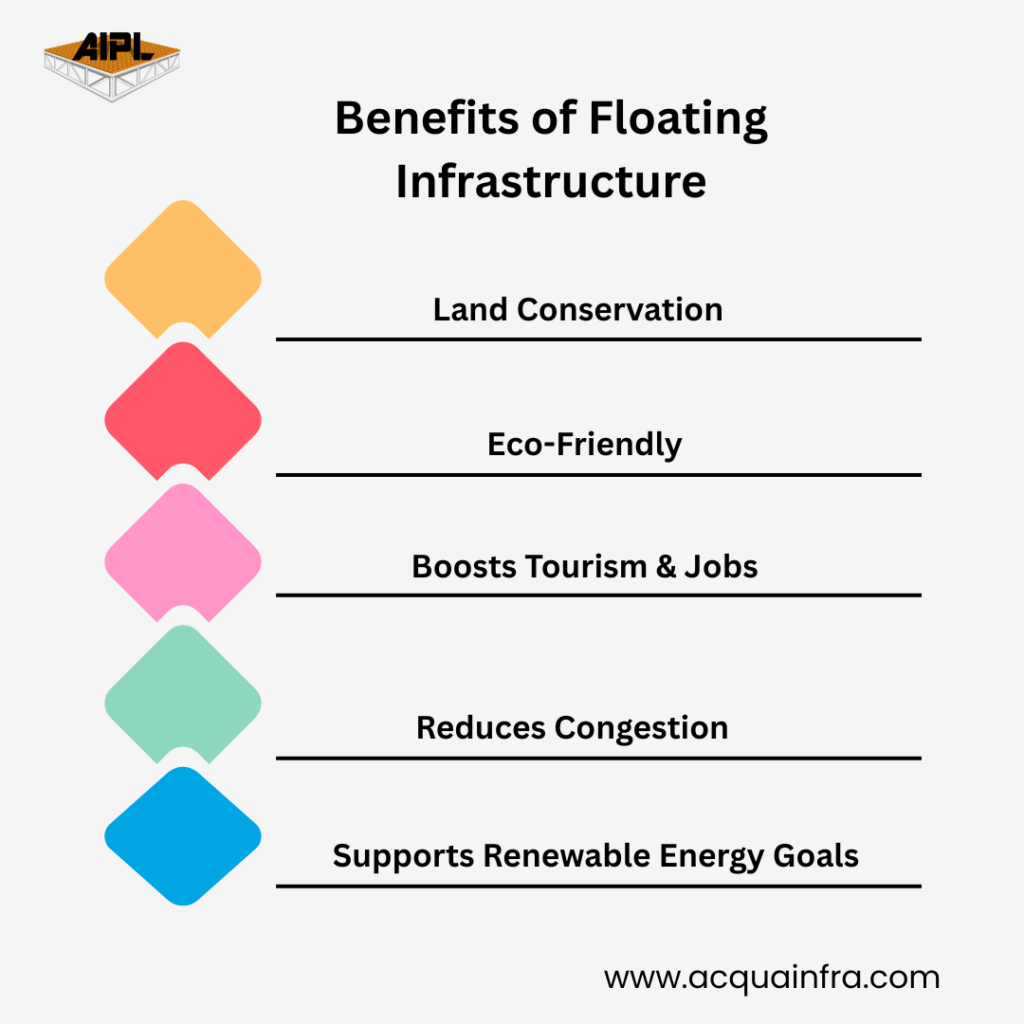
India’s rich coastline and extensive network of rivers have long held untapped potential for economic growth. Now, with the government’s push for a sustainable blue economy, floating infrastructure projects are becoming the backbone of this strategy. From floating jetties to floating solar power plants, these projects are unlocking new economic corridors and opportunities for tourism, logistics, clean energy, and maritime trade.
In this blog, we’ll explore how floating infrastructure projects are fueling India’s blue economy, actual project examples, their benefits, and how expert firms like AIPL are actively contributing to this maritime movement.
The blue economy refers to the sustainable use of ocean and waterway resources for economic growth, improved livelihoods, and job creation, while preserving marine ecosystems. It includes:
India, with a 7,500+ km coastline and 111 national waterways, is strategically positioned to lead in this sector.
Floating infrastructure refers to modular or custom-engineered structures built to float on water — rivers, lakes, backwaters, reservoirs, and coastal areas — enabling economic, tourism, energy, and logistical operations where conventional land-based infrastructure is either impractical or environmentally disruptive.
Location: Goa, Maharashtra, Gujarat, and Kerala
Details:
As part of the Sagarmala initiative, multiple floating jetties are being built to support coastal and riverine passenger movement, cargo handling, and tourism. The floating jetty at Captain of Ports, Panjim (Goa) is operational, facilitating better water taxi services and cruise docking. Similar jetties are planned at Haldia (West Bengal) and Vijayawada (Andhra Pradesh) on National Waterway-4.
Significance: Reduces pressure on congested land ports and enhances local economy through tourism.
Location: Khandwa, Madhya Pradesh
Details:
India’s largest floating solar power project under construction — a 600 MW floating solar power plant on the Narmada river’s Omkareshwar reservoir. It will help power nearby villages and industries while conserving land.
Significance: Supports clean energy generation while utilizing unused water surfaces.
Location: Assi Ghat, Varanasi & Ashtamudi Lake, Kerala
Details:
Floating restaurants and houseboats like Alleppey’s luxury floating hotels and Varanasi’s floating cafeteria and multi-cuisine restaurant enhance waterfront tourism while creating new livelihood opportunities for locals.
Significance: Drives cultural, spiritual, and eco-tourism.
Location: Haldia (West Bengal) to Varanasi (Uttar Pradesh)
Details:
The World Bank-supported Jal Marg Vikas Project includes floating terminals, pontoons, and cargo handling facilities along NW-1. Regular container and cargo movement is operational between Haldia, Sahibganj, and Varanasi.
Significance: Shifts bulk cargo from road/rail to waterways, reducing congestion and logistics costs.
Floating Advertising Platforms in Mumbai & Udaipur
Location: Mumbai’s Marine Drive, Udaipur’s Fateh Sagar Lake
Details:
Floating LED boards and event platforms are being deployed for tourism campaigns and festivals. Companies like AIPL have pioneered floating event stages in Rajasthan for Lake Festival and public events.
Significance: Innovative, eco-friendly advertising without occupying prime land space.
Location: Khirkiya Ghat, Varanasi
Details:
World’s first floating CNG filling station built on a 324 sq. m modular mild steel barge by AIPL for GAIL India. Designed to refuel CNG boats and cruises on the Ganga, it operates year-round, even during floods.
Significance: Reduces air, noise, and water pollution—advancing clean mobility and river conservation.

At AIPL (Acqua Infrastructure Pvt. Ltd.), we are actively engaged in floating infrastructure projects contributing to India’s blue economy. Key offerings include:
With our strong presence in Udaipur, Mumbai, Goa, and Varanasi, we have successfully delivered modular pontoons, floating docks, and event platforms for both public and private sector clients.
Q1: What is Acquafront Infrastructure Pvt. Ltd. (AIPL), and what does the company
specialize?
A: Acquafront Infrastructure Pvt. Ltd. (AIPL) is a pioneering company specializing in the
design, manufacturing, and installation of advanced floating infrastructure systems for
maritime and inland waterways. Since 2018, AIPL has been delivering IP-driven and
sustainable turnkey solutions tailored for sectors such as water supply, renewable energy,
tourism, dredging, defence, and transportation.
Q2: What types of floating structures does AIPL offer?
A: AIPL offers four major types of modular floats tailored for diverse industrial
applications:
MS Modular Barges
Steel Integrated Floating Jetty (SIFJ)
GFRC (Glass Fiber Reinforced Concrete) Floating Beams
HDPE Cubes
Q3: Where are your corporate office and manufacturing facilities located?
A: Corporate Office:
3rd Floor, Tower-C, Office No. C-320, I-THUM, Plot No. A-40, Sector-62, Noida, Gautam
Buddha Nagar, Uttar Pradesh – 201301
Q4: Are your designs compliant with Indian standards or certified by third-party
institutions?
A: Yes, all our designs adhere to applicable Indian Standards such as IR-Class, IS 800, IS
456, IS 875, etc. Additionally, we support third-party design vetting through agencies like IR
Class, IITs, and Naval consultants as required.
Q5. Who are some of your key clients and past projects?
A: AIPL has delivered floating infrastructure solutions for prestigious clients such as:
Q6. How can I get in touch with AIPL for a new project or partnership?
A: You can submit your inquiry directly through our website’s contact form:
https://acquainfra.co
